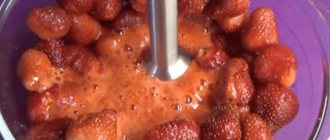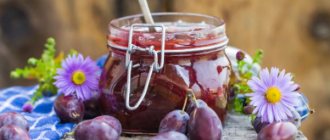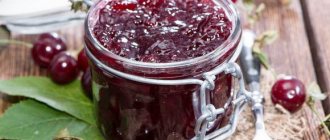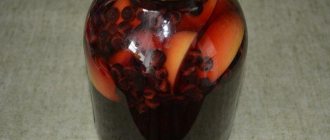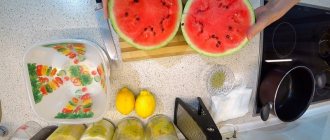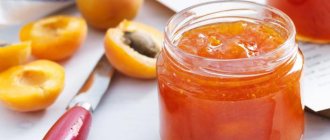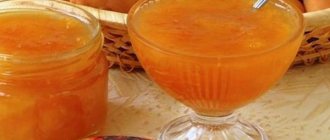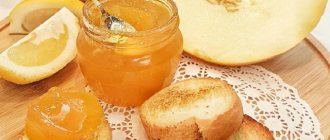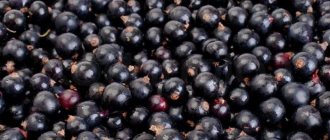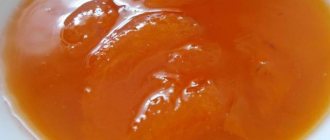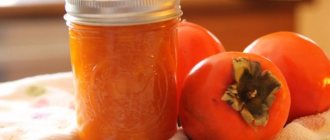Difference between jam and preserves
Summer flies by in an instant, and all that remains is to look through the photos, slowly wash off the tan, and enjoy the homemade preparations made for winter. And if our grandmothers prepared mainly jam, marmalade, compote and juice, then the vocabulary of modern housewives has expanded significantly. Now on the table you can see confitures, nectars and jams, which, by the way, are often confused with preserves. In fact, many are sure that jam is simply a “foreign” name for a childhood favorite delicacy. However, this is not quite true.
The content of the article
The word "jam" is originally English. Jam means a jelly-like mass made from boiled products with added sugar. Jams can have either a solid thick consistency or with pieces of fruit. There are jams made from one type of berry or fruit, but it is also quite common to find jams made from several types. To make jam, the appearance and ripeness of the berries are not important. They may be slightly bruised or underripe.
Strawberry jam
Jam is fruits or berries boiled in syrup, which retain their shape when cooked. As a rule, jam is made from one type of fruit or berry. At the same time, the berries are selected carefully: they all must be of the same degree of ripeness and retain their shape. The jam looks transparent, with clearly visible berries.
Strawberry jam
Method for making jam and marmalade
The first stage in making jam is the labor-intensive selection and preparation of berries. They must be washed, peeled and cut. Now the ingredients can be lightly boiled. After this, the berries are poured with syrup and boiled. To make the mass jelly-like, pectin is added to it. When cooking, the heat should be constantly increased, even after boiling. Boiling should be distributed evenly, and foam should be removed. The jam will be ready when a drop of it falls on the plate and thickens. The jam is packaged in small jars; it is not necessary to roll up the jam.
There are a great many ways to make jam, and every housewife has her own secrets. Therefore, we will focus on the classic recipe. At the first stage, the berries and fruits are thoroughly washed and peeled, if necessary. If the berries or fruits are large, then they can be cut. In fruits that have seeds, they are removed. Most often, an aluminum basin is used to make jam, in which syrup is diluted: sugar and water. Fruits or berries are placed in hot syrup and then boiled. There is another method that does not involve sugar syrup; this is to fill the berries with sugar and leave them for 24 hours. The berries are cooked over low heat for 30-40 minutes. The first sign of readiness is the appearance of foam. Next, the jam is poured into containers and rolled up. In some cases it is closed with a nylon lid.
Application
Jams are great for baking, as they have a thick consistency and practically do not spread. They are added to ice cream, desserts and yoghurts.
Jam is eaten as a completely self-sufficient product. Often used as a sauce for sweet dishes, such as pancakes. It is not recommended to put it inside the pies, as the jam spreads quickly. But you can decorate homemade baked goods with whole jam berries.
Conclusions TheDifference.ru
- Jam is jelly-like, while preserves can have either a thick or thinner consistency.
- You can put damaged fruits or berries into the jam; only selected ones go into the jam.
- The jam is cooked over low heat, while the heat is constantly increased when cooking the jam.
- Jam can be used as a filling for pies, and in this case the jam will spread.
thedifference.ru
Are there any benefits to eating a sweet treat?
If we talk about the preservation of beneficial vitamins and elements contained in the original berries or fruits, then the maximum amount remains, of course, in the jam. Everyone knows that raspberry delicacy is indispensable for fever, viburnum helps reduce blood pressure, and apple dessert improves the functioning of the stomach and intestines. This is especially true for five-minute jam, where substances valuable for health are subject to minimal heat treatment, and therefore are destroyed less. Other types of sweet desserts: jams, confitures and jams - due to lengthy and aggressive processing, they lose almost all the value of the original raw materials.
In addition, lovers of jam and its derivatives should remember that consuming this delicacy in excessive quantities can negatively affect health: it will increase blood glucose levels and create additional stress on the pancreas.
Date: 08/01/2016.
Updated: 07/17/2018
Photo: nakormi.com
Jam, preserves, confiture - what's the difference?
Sweet preparations made from fruits and berries are very popular in the world. Jam, confiture, jam are often added to baked goods, served with tea and coffee, eaten with pancakes, porridges, etc. Each delicious preparation has its own characteristic features and characteristics.
The content of the article
Jam, as many culinary historians believe, appeared in Ancient Rus' (according to less popular versions, in the East). In those days, instead of the sugar we are used to today, honey was added to the product during preparation or it was cooked by boiling for many hours without any additives at all. The result was a delicious sweet preparation with whole berries.
It is the leaving of berries/fruits in their original (or cut) form that is the main distinguishing feature of jam. The pieces in a thick sweet syrup retain many vitamins. Therefore, jam is considered the most useful treat for colds. Most often, raspberry or cranberry is used as a “medicine”. Jam originated in the British Isles. The name of the delicacy comes from the word “jam” - “to crush”, “to mix”. As can be seen from the translation, berries and fruits are subjected to serious mechanical processing and are not left whole. As a result, the jam is a homogeneous sweet mass. Fruits/berries are boiled in sugar syrup for a long time until the delicacy acquires the required texture. Not all berries or fruits are suitable for making jam. Preferably those with a high pectin content are used - with its help the mass gels well and becomes denser. Therefore, you can most often find jam made from apples, black currants, quinces, etc. This delicacy is very popular in England, Ireland, and Scotland: jam is eaten for breakfast with toast and butter. Confiture was invented in France. This product has a very dense consistency, which is obtained due to the addition of additional substances during the preparation process (for example, agar-agar, pectin, etc.). When cooking confiture, both whole/piece and highly crushed ingredients are used. It should be noted that the sweet product never contains gelatin, because... when heated, it loses its properties. Thus, it is clear that jam, preserves, and marmalade have both similarities and differences. The former are reflected in the cooking methods and ingredients. All sweet preparations are obtained by boiling in syrup with the addition of honey or sugar. Jam, preserves and confiture can be made from both berries and fruits.
The differences lie in the consistency of the dishes. The jam is more liquid and consists of fruit/berry-sugar syrup and pieces. Jam is dense and homogeneous. Confiture, thanks to the addition of special substances, more closely resembles jelly. It can contain both highly crushed products and whole ones.
Jam, preserves, confiture - what's the difference?
www.kakprosto.ru
What dessert is called jam?
It is generally accepted that jam was invented by the Hellenes, who boiled mythological “golden apples” (quinces) in honey. Later, this recipe underwent some changes, and traditional apples, plums and pears, as well as more exotic lemons or rose petals, began to be prepared in honey syrup.
Much earlier, an eastern version of this sweet appeared, closer to the modern one. In Persia, sugar was added to fruits instead of honey, but jam was used as a sauce, flavored with a large variety of spices.
What is the difference between jam and jam, marmalade and marmalade?
What a great variety of sweet desserts are invented based on berries, fruits and even some vegetables, boiled with sugar and carefully placed in jars, so enticing to those with a sweet tooth. Typically, these desserts are used as a filling in homemade baked goods or eaten spread on toast, washed down with hot tea. But many of us find it difficult to understand the difference between preserves, marmalade, marmalade and confiture, and what is the technology for preparing this or that aromatic dessert. Let's talk about their differences and other unique qualities. This way it will be easier for us not to get confused in their various names.
Jam
How to understand which product is in front of you? What is the difference between jam and marmalade?
First, we will describe the preparation of a classic variation of jam. In order to get the right jam, you need to boil berries or chopped fruits with sugar. While preparing this dessert, you need to monitor the transparency of the syrup. High-quality jam should have as clear a syrup as possible without inclusions. The berries and other ingredients from which this dessert is prepared must keep their shape and in no case fall apart. To fully answer the question of how jam differs from jam, let’s consider the technology by which it (jam) is prepared.
If the housewife made jam, but the syrup turned out to be very thick, then she ended up with a different product. Moreover, if fragments of fruits are visible in the syrup, they were damaged during cooking and fell off from the main fruit or berry. In this case, no matter how hard the housewife tried, she made jam. Thick syrup and boiled berries are only acceptable for jam. This is the difference between jam and preserves.
Smooth or wrinkled?
Slightly bruised and even damaged fruits are suitable for making jam. It is especially preferable if the fruits contain a lot of pectin substances. Pectin is a substance that helps jam acquire its characteristic stability. If jam can flow, then in the case of jam this is unacceptable. This is another point that distinguishes jam from preserves. With jam you can forgive the weakness of the syrup; for jam this is not normal.
During jam cooking, its readiness is determined by how the cooled product behaves. The mass should not pour from the spoon, but fall off in pieces. Let's hope that now you know exactly how jam and jam differ.
Jam
It is made from very finely crushed fruits. Jam is most often prepared from apples and plums. In addition to fruit ingredients, it contains sugar. Also, for a more interesting aroma, cloves and cinnamon are added to the jam. The result is a very thick dessert that is sweet and has a smooth texture. This is exactly what distinguishes jam from jam and jam.
Jam can be made from overripe and unsightly fruits. In the general mass, it will no longer be visible how beautiful or ugly the fruits were as the basis for the jam. Their beauty does not affect the taste of the finished product. The readiness of the dessert is determined by running a wooden spatula across the bottom of the wide bowl in which it is cooked. If the resulting path fills with jam slowly, you can turn off the stove. Dessert is ready.
What is the difference between confiture and jam?
Confiture is considered to be a close relative of jam. But confiture has a more jelly-like, transparent base, in which preserved, undamaged pieces of berries and fruits are visible. You can even see whole berries in this delicate, beautiful dessert.
Apricots, quinces and apples were the first fruits from which confitures began to be prepared. The dessert was invented in France, and the French thought of adding gelatin to the clear syrup. For a more interesting coloring, berry juice was (and is still being used) used in confiture.
Confiture is prepared from peeled and blanched berries and fruits. You can use fresh or frozen berries.
The fruits are boiled for some time in syrup with added sugar. Then add gelatin or agar-agar, which are harmless thickeners.
To make the taste more pleasant, the confiture is acidified with citric acid and vanillin is added.
To prevent the mass from sticking to the bottom of the dish, under no circumstances should it be mixed with a spatula or spoon. Such manipulations will spoil the integrity of the berries included in the prepared dessert. Mixing occurs by gently rotating the container in which the confiture is cooked. Then all the berries remain beautiful and whole, and the syrup remains transparent.
If the fruits intended for confiture are small in size, then the dessert can be cooked at one time. But if the fruits have a dense texture or are large, then cooking takes place in several stages. Each time it is necessary to completely cool the prepared confiture at room temperature.
The readiness of the tender and sweet confiture can be determined by the pieces of fruit (or whole berries) evenly distributed throughout the mass.
As you can see, the most work and ingenuity is needed when cooking confiture. But the end result is a delicate, aromatic and beautiful dessert.
fb.ru
Confiture is a relative of jam
If on the shores of Foggy Albion they prefer a uniformly thick sweet mass, then on the other side of the English Channel, in France, they fell in love with a more delicate, jelly version, which preserved the shape of the fruit intact. The first confitures were made from quince, apricots and apples. For better gelling, the French began to add gelatin, and for intense coloring - berry juice.
To properly prepare confiture, you should know several basic nuances of the process:
- For preparation, you can take fresh or frozen fruits and berries, peeled and pre-blanched.
- After boiling the fruits in sugar syrup, a thickener is added to the mass. Usually agar-agar or gelatin plays this role.
- To improve the taste, confitures are often flavored with vanillin or citric acid.
- To avoid burning of the sweet mass, it must be stirred regularly. This should not be done with a spoon, but by rotating the dish, otherwise the pieces of fruit or berries will lose their shape.
- Confiture from delicate and small fruits is prepared in one cooking, and from denser and larger fruits it is boiled repeatedly, allowing it to cool completely in between.
- The confiture is completely ready if the pieces of fruit are evenly distributed throughout the mass.
How is jam different from marmalade?
How nice it is to open a jar of jam in winter! Or jam? What is the difference between jam and marmalade? Jam is some kind of foreign word, jam is another matter, it is clear that it comes from the word boil.
But the difference between jam and jam is not only in the origin of the word. It's all about the form... When making jam, they strive to ensure that the berries retain their shape and do not turn into mush.
When cooking jam, some precautions are taken - before cooking, soak the fruits in syrup and cook in several stages.
- An important indicator is the quality of the syrup. The jam syrup should be clean and transparent.
- The syrup should not gel, but should be mobile and easily separated from the cooked berries.
And now about jam - differences from preserves
When making jam, it is not necessary to strive to maintain the original shape of the berries. Often, before cooking, the berry mass is turned in a meat grinder. In order for the pectin contained in the fruits to have a greater gelling effect, the prepared fruits are crushed or, as mentioned above, turned through a meat grinder, or in another way.
- The syrup in the jam should gel well and not spread.
- Jam is always cooked in one step
- Jam is made from fruits containing a large amount of pectin, that is, they gel well
If jam is made from poorly gelling fruits, then juice from fruits and berries that produce good jelly is added. Such fruits and berries include gooseberries, red currants, green varieties of apples, apricots, and quince. Jam, like preserves, is made pasteurized in hermetically sealed jars, or unpasteurized, intended for storage in barrels. After collecting berries or fruits from your garden, decide for yourself what to make jam or preserves.
The main difference between jam and preserves is the ability of berries and fruits to gel well
On this topic you can read:
How to make berry jelly. Jelly made from fresh juice is an exquisite delicacy. What berries can you use to make excellent jelly, and how to do it correctly.
Raspberry jam. Raspberry jam is both a delicacy and a cure for colds. Be sure to make raspberry jam for the winter. The article provides two proven simple recipes.
If you liked the article, please like it. Just share with your friends on social networks. This will help us make the site better. Thank you!
Tags: healthy eating, berry crops
telo-v-delo.ru
Jam - a delicacy originally from Poland
The name “jam” itself is of Polish origin, since it was there that more than a century ago they already knew how to boil the pulp of the Hungarian plum for a long time without adding sugar, and then bake it in the oven. Such sweetness could be stored in the cellar for several years.
Nowadays jam is also prepared using fruits crushed to a puree. In the modern version of the dessert, sugar is necessarily added, as well as, if desired, citric acid and various spices (cloves, cinnamon and others). Properly cooked jam is very sweet, thick and homogeneous. In order for it to turn out exactly like this, you should know some cooking secrets:
- Not only ripe, but also overripe, damaged and wrinkled, but not spoiled, fruits are quite suitable for jam.
- To obtain fruit puree, the fruits are peeled and blanched (the denser fruits are boiled), and then passed through a meat grinder or rubbed through a sieve or colander.
- For cooking, always use wide dishes so that the liquid evaporates more intensively.
- To prevent burning, the thick mass is continuously stirred using a wooden spatula. This process is dangerous, as the boiling mixture splashes heavily and can cause burns.
- It’s easy to determine if the jam is ready – just run a spatula along the bottom of the pan. If the resulting “track” fills slowly, then the dessert is completely ready.
see also
- Blackberry jam for the winter with lemon
- What can you bake with jam - simple recipes
- Overripe peach jam
- How Luntik collects jam
- Five-minute jam from serviceberry for the winter
- How long to cook Victoria jam?
- How to make homemade wine from jam
- Gooseberry jam with apples for the winter recipes
- Apricot jam recipe for the winter, five minutes
- Peach jam with agar agar
- Apricot and orange jam
Basic definitions
- Jam is whole fruits or berries in a relatively liquid syrup, most often transparent. The syrup is viscous, but quite fluid. The syrup can be drained - it is separated from the berries.
- Jam is almost completely boiled fruits or berries, but the mass is not homogeneous. The syrup is completely opaque, relatively thick, but not gelatinous; it cannot be separated from the berries; it forms a single mass with them.
- Jam is a smooth fruit or berry puree of uniform consistency, thick, but still maintaining a spreadable consistency.
- Confiture in some countries means a finished product such as jam, and in France, according to the gastronomic encyclopedia, confiture is jam in our understanding.
- Marmalade is a product that is whole or cut into pieces fruits and berries, soaked for 24 hours in sugar (1:1 ratio), and then boiled to a puree consistency. Unlike jam or confiture, marmalade is a homogeneous mass in which individual fruits are not distinguishable. The word “marmalade” comes from the Portuguese marmelo - quince; in Russia, marmalade is a confectionery product with a jelly-like consistency.
- Jelly is the condensed juice of fruits or berries, usually transparent and jelly-like.
Jam has always been the main strategic reserve of Soviet housewives. If there was jam in the cupboard, then a sudden visit from any guests was not scary! Tea with lemon and two or three vases of jam solved all the problems of hospitality and were one of the most important temptations of childhood!
Basic definitions.
Jam is whole fruits or berries in a relatively liquid syrup, most often transparent. The syrup is viscous, but quite fluid. The syrup can be drained - it is separated from the berries.
Jam is almost completely boiled fruits or berries, but, nevertheless, the mass of fruit is not homogeneous. The syrup is completely opaque, relatively thick, but not gelatinous; it cannot be separated from the berries; it forms a single mass with them.
Jam is a smooth fruit or berry puree of a completely uniform consistency, thick, but still maintaining a spreadable consistency.
Jelly is the condensed juice of fruits or berries, usually transparent and jelly-like.
The classification I have given is from Soviet books, for example, from Kravtsov’s book “Home Canning”.
But in principle, all group names are quite arbitrary and mean different things in different countries. For example, confiture in some countries means a finished product such as jam, but in France, as Larousse argues, confiture is jam in our understanding. Or such a thing as marmalade. As Larousse and other respected sources define it, “marmalade is a product that is whole or cut into pieces fruits and berries, soaked for 24 hours in sugar (1:1 ratio), and then boiled to a puree consistency. Unlike jam or confiture, marmalade is a homogeneous mass in which individual fruits are not distinguishable. According to the European Union Directive of 1981, the trade name marmelade applies exclusively to citrus fruit jellies.
Although the word “marmalade” itself comes from the Portuguese marmelo - quince, in Russia marmalade was even called a confectionery product with a jelly-like consistency.
What is jam and jam made from?
It’s easier to say what they don’t cook from.
Berries and fruits are understandable.
But jam is also made from vegetables: carrots, pumpkin, sweet potatoes, peppers, red and green tomatoes, eggplants.
Green walnuts and almonds, various flowers: roses, mimosa, violets, jasmine, acacia...
Alcohol, chocolate, cocoa, vanilla, cinnamon, pepper, bay leaf, basil are used as additives. A plant with green or purple leaves that have a pronounced taste and aroma. Due to the content of aromatic substances, basil leaves and stems are used, both fresh and dried, as a seasoning for sauces and soups. Rosemary Rosemary has a strong aromatic sweetish and camphorous odor, reminiscent of the smell of pine, and a very spicy, slightly pungent taste. . Leaves, flowers and young shoots in fresh or dry form are used as a spice for processing fish; in small quantities they are added to vegetable soups and dishes, salads, minced meat, fried meat, fried poultry, mushrooms, red and white cabbage. cabbage and marinades. They add a pleasant taste to soft cheeses, potatoes, game meat, fish and pastries. and so on.
There are no limits to imagination! Depending on what you are going to cook - jam, jam or preserves - you need to choose raw materials. Only very hard and fresh berries and fruits, some even unripe, and preferably small ones, are suitable for jam. The smaller the strawberries, apricots and peaches, the more likely they are to retain their shape in jam. Important: the degree of ripeness must also be the same, otherwise some fruits will boil before others, less ripe, become soft.
If you are making jam, then on the contrary, you need to choose very ripe raw materials, or even overripe ones. For jam, the raw materials do not need to be sorted. Different degrees of ripeness will provide its characteristic structure - puree with particles of uncooked fruit.
What do you use to make jam? Previously, every self-respecting housewife had a copper or brass basin for making jam. Basin - because it is advisable not to stir the jam, especially at the end of cooking, so as not to injure the berries and fruits that have become soft. Therefore, the raw materials should lie in one layer, and a large diameter basin with a flat bottom is ideal for this purpose. Jams - and especially marmalade - do not require such careful treatment of raw materials, and besides, they boil down more strongly, greatly decreasing in volume. Therefore, they can be cooked in large-capacity cauldrons, as my grandmother once cooked. A huge cauldron was placed in the garden, filled to the top with plums (without sugar) and a small fire was lit under the cauldron. And so, for about 10 hours, constantly stirring with a stick, we cooked plum jam. As a result, by the end of cooking, about a quarter of the original volume of completely smooth, dark and shiny jam, reminiscent of prune pulp, remained in the cauldron, which was stored all winter without any refrigerators.
In our modern kitchens, a brass basin is replaced by a stewpan or a flat, low saucepan with a multi-layer bottom.
Just keep in mind that in this case the jam will have to be cooked in small batches.
So, in a saucepan with a diameter of 30 cm you can put no more than 1 kg of berries (not counting sugar), and in a saucepan with a diameter of 24 cm - no more than 600 grams.
If you make jam, then the amount of raw materials can be doubled or tripled.
The role of sugar.
Sugar gives sweetness, everyone knows that. And it is also a preservative if its percentage is high enough.
But given its low usefulness and high calorie content, the best minds of humanity are struggling with the problem of how to make jam without sugar.
And they cook! In juices, with pectin, with sweeteners...
It would seem that everyone should shout joyfully and throw caps into the air?
But no, we continue to buy sugar in bags and make jam like our grandmothers did.
And all because reducing the amount of sugar leads to the fact that it is not possible to make beautiful jam; fruits (especially those with red pigment) lose their color and become soft.
Sugar is very hygroscopic; it binds water, drawing it out of the fruit and, through the process of osmosis, filling its place with a viscous solution. That is why fruits covered with sugar and kept for a sufficient time become denser and retain their shape during cooking.
In addition, thick sugar syrup envelops the fruit and, thereby, prevents the decomposition of pigments that color the fruit and the destruction of fruit fiber - sugar glues the pulp, which softens from heat.
The minimum amount of sugar with which you can make decent jam is 700 grams per 1 kilogram of raw materials.
Maximum 1.5 kg per 1 kg of raw materials.
Most, without further ado, take 1:1 and cook everything just like that, which is not always true.
You need to understand a simple thing: the absolute amount of sugar is not so important, its concentration in the syrup is important.
A concentration of 65-67% is considered normal, which corresponds to the temperature of the syrup at the end of cooking = 104C-107C.
In other words, I can take 300 grams of sugar per kilogram of berries, but in order to get jam of the required consistency, I will still have to boil the syrup to the required sugar concentration.
I want to clarify that everything written correctly applies only to jam, which is difficult to boil down while maintaining the integrity of the berries or fruits.
There is no such problem with jam; it can be cooked completely without sugar precisely because it can be boiled down.
Sugar syrup.
In order to make jam, marmalade or jelly, we need liquid to dissolve the sugar.
In principle, sugar can be melted without liquid if you heat it over low heat, starting with a small portion and adding the remaining sugar little by little. But this is very time-consuming, labor-intensive and risky - the syrup can very quickly turn into caramel.
Therefore, sugar is dissolved in water or fruit juice.
To obtain juice from fruits, the raw material is covered with sugar and left for a period of several hours to several days. Sugar, being highly gyroscopic, will draw out the juice and dissolve in it.
What can you add sugar to:
- peeled cherries, sweet cherries (i.e. pitted)
- halves or quarters of apricots, plums, peaches
-slices of apples, pears, etc.
But if you don’t have time to age fruit with sugar, or you are making jam from cherries with pits, apples of paradise and any other raw material that has a thick peel, you need to boil sugar syrup with water.
In this case, the minimum water that needs to be added is 1 tablespoon of water per 100 grams of sugar.
Whether you make sugar syrup with water or juice, the procedure is the same:
pour the juice with sugar or water with sugar into a bowl for making jam, stirring constantly, bring the syrup to a boil over medium heat and let the sugar dissolve completely. Only after this add berries or fruits.
Pectin is a gelling substance of plant origin, found in vegetables, fruits, and root vegetables. In the confectionery industry and at home, pectin is used to make jellies, marmalade, and jams. At the moment, apples, sugar beets, citrus peels, and sunflowers are most often used as raw materials for the production of pectin. You can read more about pectin in the article on the website.
Natural pectin is found in all fruits and vegetables.
In unripe fruits, pectin is a gelling substance of plant origin, found in vegetables, fruits, and root vegetables. In the confectionery industry and at home, pectin is used to make jellies, marmalade, and jams. At the moment, apples, sugar beets, citrus peels, and sunflowers are most often used as raw materials for the production of pectin. You can read more about pectin in the article on the website more than in ripe ones, which is why ripe fruits are much softer than unripe ones.
Natural pectin is concentrated in the skin and core.
Particularly rich in pectin:
apples, blackberries, gooseberries, cranberries, grapes, medlars, plums and quinces. All citrus fruits also contain a large percentage of pectin in their peel.
Fruits low in pectin include apricots, blueberries, cherries, peaches, pears, raspberries, strawberries and rhubarb.
Now you understand why it is so difficult to make beautiful strawberry jam, and why cherry jam usually requires more sugar.
In order to make thick jam and use less sugar, industrially produced pectin is used.
Methods for making jam.
Jam requires a special approach, because the goal - to obtain a clear syrup with whole berries or pieces of fruit - is not easy to achieve. Firstly, no matter how carefully you select the raw materials, you will still find riper, and therefore softer, fruits. Secondly, there are initially very tender berries and fruits that instantly become soft.
Each housewife has her own secret and her favorite technique that she uses. Secrets, of course, are told by ear, and if your grandmother or mother has such a secret, be sure to master it, it is a real treasure! As for the technical side of the issue, the actual cooking methods, there are no secrets. Any jam begins with the addition of sugar to the raw material. Adding sugar causes the fruit to release juice and firm up (see above) and also helps to release pectin (see above).
This can be done only in two ways:
A ) Filling with boiling syrup. Prepared berries or fruits are poured with boiling syrup (sugar plus water), kept in this syrup for some time - from 3 to 6 hours. Then boiled with or without resting.
B ). Topped with sugar. Prepared berries and fruits are covered with sugar and left in a cool place for 6 to 48 hours.
For example, berries such as raspberries and strawberries are kept in sugar for 3-4 hours, cherries for a day, apricots for 48 hours.
After the juice has been released, the jam is boiled. The goal is to bring the syrup to the desired degree of thickness, the raw materials to the desired stage of readiness, and at the same time not allow it to boil over.
B ) Continuous cooking.
The fruits are placed in a colander, the drained syrup is poured into a basin (pan), and brought to a boil. Add fruit and cook until fully cooked, usually 30-40 minutes. You don’t have to boil the syrup in advance, but immediately heat the fruit along with juice and sugar, but this requires more care, since wet, undissolved sugar always collects at the bottom, and it can burn.
For example, cherries, sweet cherries, and raspberries are cooked in one stage.
D ) With exposure (cooling breaks). Breaks (holding) make it possible to cook raw materials using residual heat, which is more gentle.
Everything is the same as in point B), only the cooking time is no more than 5-10 minutes (depending on the recipe). Then the basin with fruit is put aside and kept, depending on the recipe and type of raw materials, from 6 to 12 hours. Return to the heat, bring to a boil again, cook briefly again, and put back to stand. Then heat it again and finish cooking.
Resting can be one-time - then after aging the jam is boiled until fully cooked, or multi-stage - when the jam is stood two to four times.
For example, blackberry jam is brewed with two extracts.
First cooking - 5 minutes, holding time 6 hours. Second cooking – 10 minutes, holding time 3 hours.
The third pass is cooking until fully cooked.
These basic methods can be used in various combinations:
A + B A+D B+C B+D
There are many recipes, finding them is not a problem. Now, I hope, it is clearer to you what is written in them. And then, yes, I admit honestly, sometimes it’s scary to read, everything seems very complicated.
But in fact, everything is simple. Experiment, don't be afraid!
In any case, the jam can be eaten. And sooner or later you will make your “ideal” jam.
Signs of jam readiness.
There are three ways.
The first is to place a thermometer in the pan for cooking syrups and wait until the temperature reaches 104C.
The second is to keep a clean saucer on hand. Some people recommend putting it in the freezer. Not necessary.
Pour some syrup onto a saucer and let the syrup cool. Draw a path in the middle of the syrup lake with the handle of a spoon. If the path does not swim, the jam is ready.
Third: Cool the syrup in a spoon and drop a drop of syrup on your thumbnail. If the drop remains round and convex, the jam is ready.
A visual signal of approaching readiness will be that the foam begins to collect in the center of the basin, and the raw material becomes translucent and does not float on the surface, but is evenly distributed in the syrup.
Storing finished jam.
It is best to store jam in glass jars.
They are easy to clean, sterilize well, and the state of the jam can be seen through the glass.
I don’t remember how many cans were needed for 1 kilogram of raw materials when adding 1 kg of sugar, but the way I cook now, exactly 1 liter jar is needed for 1 kilogram of raw materials and 300 grams of sugar.
Once upon a time, jars were thoroughly washed, scalded with boiling water or even sterilized, put on a stick and dried over a primus stove.
Today I put clean jars in the oven, heated to 110C or in the microwave (along with a glass of water!) and sterilize them for 10-15 minutes.
Some useful tips.
- if the jam is poured into jars while hot, it may separate, the berries will float, and the syrup will concentrate at the bottom. Therefore, it is advisable to let the jam cool completely in the basin, and only then transfer it to jars.
- watch the flame carefully, it should not heat the walls of the pan, otherwise the syrup may burn.
- do not stir the jam like soup. It is best to take a spatula and move it along the bottom of the basin (saucepan), under the fruit. If you need to mix fruits and berries, it is better to do it this way: take the bowl handles (or the edges) and sharply move the basin in a horizontal plane, without lifting it from the burner. Just be careful not to overdo it, hot syrup is a scary thing. Burns can be very serious.
- to remove the foam, you need to drive it to the center of the pelvis. They do this in exactly the same way as I wrote above - moving the pelvis in a horizontal plane.
- if you see caramel clots on the shoulder blade, it means the jam has started to burn. Take immediate action: pour the jam into a clean bowl, without scraping what is stuck to the bottom. Wash the basin and continue cooking. If you realize it in time, the jam will taste normal. If not... the jam will be bitter. It's a pity. Be vigilant and do not leave it unattended in the kitchen!
- if you have jam in a large jar, then I do not recommend allowing everyone to take jam directly from it. This can lead to mold appearing or the jam starting to sour. Using a clean, dry spoon, scoop the jam into a small jar and place in the refrigerator for general use. Then repeat as needed.
Confiture
The confiture has a jelly-like consistency with inclusions of small pieces of fruit. It is obtained from apples, quinces, strawberries, raspberries, plums, cherries, cherries, apricots and peaches. When making confiture, whole or chopped fruits are immersed in sugar syrup with the addition of 5-16% pectin concentrate, citric acid, and vanillin. Cooking is carried out quickly (25 minutes) in a vacuum apparatus, due to which pectin substances, vitamins, color, taste and aroma of the fruit are better preserved.
According to the quality, confiture is divided into extra and premium grades. The content of dry substances in confiture is higher than in preserves and jam - 70-75%.
Selling jams from Samovartime
We produce decoupage teas, and jam suppliers collaborate with us to create sweets in addition. They are as healthy and tasty as homemade ones. You can buy jams wholesale from Samovartime at special distributor prices. There is a special line “Russian Forest”, created without a gram of sugar from Russian berries.
- Green pine cone jam for health.
- An unusual jam made from pine syrup, nuts and rosehip syrup.
- A delicious version of Russian wild berries, according to an old recipe.
Jam production takes place in a clean area of the Perm region. Contains artesian water from a well in a natural pine forest. This completely natural product will be useful for both adults and children. There are no store-bought preservatives or harmful substances present.
What is jam?
Always made from whole or sliced fruits and berries, pureed with sugar, spread on toast, used in baked goods, popular as a base in many tarts.
The word "jam" is often used to describe almost any canned fruit and berry product. And the description means that jam is fruit or berries prepared with sugar or pectin from puree.
Real jam should be so thick in consistency that it can be spread on toast and used as a filling in baking cookies, tartlets, and cakes. Real jam cannot be liquid or very thick. Jam, prepared correctly and placed in sterile jars, will be stored for up to a year, as the amount of sugar in it helps to preserve the quality.
The right jam always retains the aroma and fresh taste of berries and fruits, since the cooking technology does not heat them up as much as when cooking jam. And you don’t need special equipment for sterilization at home. All you need is a pan for preparing hot pectin, clean glass jars with lids or freezer containers. It is better to use firm but ripe berries and fruits without trying to process spoiled ones.
Strawberry jam for the winter - a simple recipe
Jam doesn't always mean standing at the stove for a long time. We recommend using pectin because this jam tastes much better and has a lot fewer calories! According to traditional recipes in jams and preserves, the ratio of sugar to berries is 1:1, and sometimes even more - 1,200 - 1,300 sugar per 1 kilogram of fruit! Where sugar plays three roles: it is
- sweetener
- thickener and
- preservative.
But sweet berries do not need large doses of sugar; sterilization can take on the role of a preservative - packaged hot, in hot and dry jars, and hermetically sealed, it is stored without a refrigerator no worse.
Just because strawberry jam is usually reduced with a lot of sugar doesn't mean you have to do it the same way. Here we will give a simple method that keeps the berries fresh by using a pectin solution, maintaining the fresh strawberry flavor. You will get good texture and flavor.
This recipe uses standard dry pectin. And here there is a nuance. You may want to reduce the sugar in this recipe. But! Sugar here not only sweetens, but also helps the pectin gel. For low-sugar jams and preserves, you'll need pectin, which is specially formulated for low-sugar recipes.
Ingredients for fresh strawberry jam
- 500 grams of fresh peeled strawberry puree
- 4 cups granulated sugar
- 50 grams (bag) of dry pectin
- 3/4 cup water.
Step by step how to make strawberry jam with pectin
- Gather your ingredients.
- Wash and dry the berries, remove the sepals, and roughly chop the berries. Mash the berries, reserving large pieces. Measure out 2 cups of strawberry puree.
- Add sugar to the puree and mix thoroughly. Let stand for 10 minutes.
- In a small saucepan, combine dry pectin and water. Stir over medium heat until the pectin is completely dissolved. Bring to a full boil for exactly 1 minute and remove from heat. Let cool for 3 minutes.
- Pour the pectin directly into the berry-sugar mixture and mix thoroughly.
- Pour the jam into clean jars or containers. Close the lids and leave for 24 hours. Store in the refrigerator for up to 1 month or in the freezer.
Try using other berries for this recipe: raspberries, blackberries, blueberries, gooseberries, even cranberries (although they will be tart).
Jam with a minimal amount of sugar and pectin immediately after preparation resembles a delicate airy soufflé, and when frozen it resembles fruit ice cream; it can be frozen in molds and eaten as such. It is recommended to store in the freezer.
